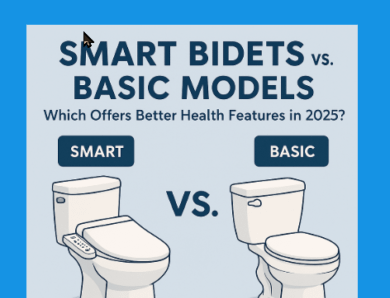Imagine transforming your daily bathroom routine into a health-boosting ritual. In 2025, bidets are more than just a luxurious bathroom upgrade—they’re becoming essential tools for better hygiene and wellness. But when it comes to choosing the right one, are smart bidets worth the investment, or do basic models hold their own?
What’s the Difference Between Basic and Smart Bidets?
🔹 Basic Bidets: Clean and Simple
Basic bidets are no-fuss hygiene tools. They usually operate manually, offering simple water spray without heating, pressure adjustment, or other enhancements. They’re often non-electric and affordable, making them a solid choice for first-time users.
🔹 Smart Bidets: Hygiene with High-Tech Comfort
Smart bidets come packed with features like heated seats, customizable spray pressure, warm water cleansing, and air drying. Many models also include self-cleaning nozzles, built-in deodorizers, and even app connectivity. They’re designed for personalized comfort and superior hygiene.
Key Health Benefits of Using Bidets
All bidets, regardless of type, offer gentler cleansing than toilet paper. This reduces irritation, minimizes microtears, and can help prevent infections like UTIs—especially for women.
“Bidet use may reduce skin irritation and infection risks, offering a hygienic alternative to dry wiping,” notes a 2021 study published by the National Institutes of Health (NIH).

Smart Bidets: A Wellness Upgrade
- Custom Water Pressure & Temperature: Great for those with sensitive skin, including people with eczema, dermatitis, or hemorrhoids.
- Warm Air Drying: Eliminates the need for toilet paper, reducing friction and the spread of bacteria.
- Self-Cleaning Nozzles: Many smart bidets feature UV sterilization, enhancing hygiene after each use.
- Remote or App Controls: Ideal for elderly users or those with mobility issues—no need to reach or twist.
- Menstrual Hygiene Modes: Some smart bidets include specialized settings for feminine care.
These features make smart bidets ideal for users recovering from surgery, new mothers in postpartum recovery, or anyone managing chronic conditions like Crohn’s disease or hemorrhoids.
“Innovative hygiene systems like smart bidets contribute to improved personal cleanliness and greater dignity for aging populations and those with chronic conditions.” — Global Hygiene Council, 2024
Limitations of Basic Bidets
While basic bidets are a step up from toilet paper, they lack key health-supportive features. Manual cleaning and no temperature control can be problematic for people with sensitive skin or mobility issues. Plus, the continued use of toilet paper undermines some of the hygiene benefits.
Comparison Table: Smart vs. Basic Bidets
| Feature | Smart Bidets | Basic Bidets |
|---|---|---|
| Nozzle Hygiene | Self-cleaning, UV options | Manual only |
| Customization | Adjustable pressure, temperature, modes | Fixed settings |
| Accessibility | Remote & app controls | Manual operation |
| Skin Compatibility | Gentle drying, warm water | Cold water only |
| Health Focus | Designed for sensitive and aging users | Limited |
Is the Investment Worth It?
Smart bidets range from $200 to $1000+, while basic models can be found under $100. That said, smart models offer long-term savings on toilet paper and potential medical costs from skin irritation or infection. Many are also designed with energy efficiency and water-saving technology.
If you or a loved one is dealing with limited mobility, postpartum recovery, or conditions like hemorrhoids, a smart bidet can be a game-changing health investment.
Who Should Choose a Smart Bidet?
- Elderly individuals or caregivers
- People with hemorrhoids or chronic bowel conditions
- Postpartum mothers
- Health-conscious families
- Anyone upgrading to an eco-friendly, paper-free bathroom
Final Thoughts: Which Is Best for Health?
While basic bidets offer a cleaner, gentler experience than toilet paper, smart bidets go above and beyond. With personalized settings, improved hygiene, and features tailored to various health needs, smart bidets are a wellness-forward upgrade for modern households.
Ultimately, the best choice depends on your needs and budget—but if health, hygiene, and comfort are priorities, the smart bidet wins hands down.












